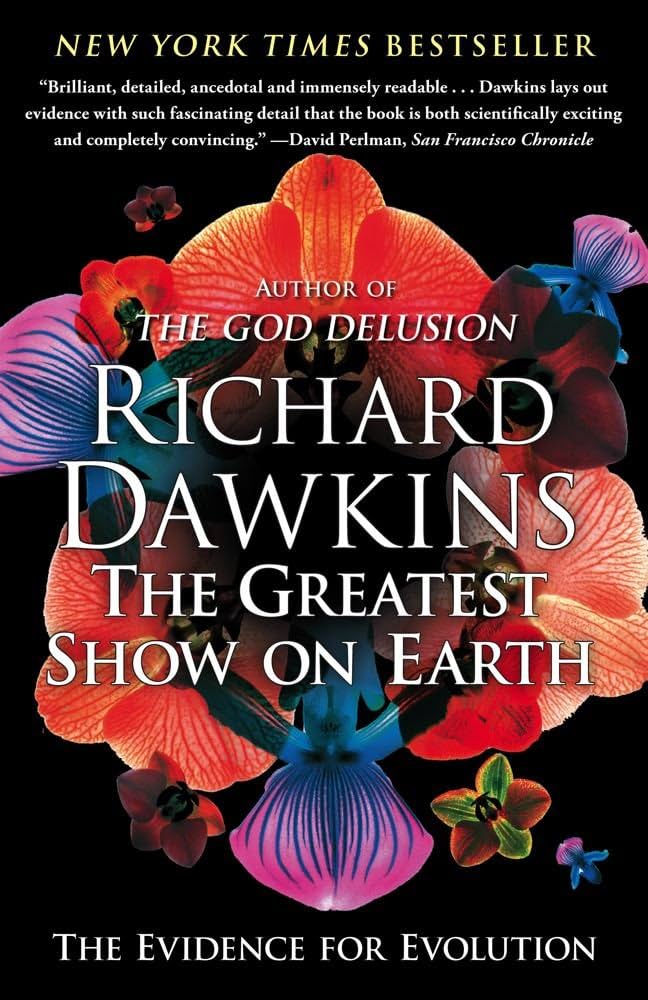In the vast landscape of scientific literature, few works have sparked as much curiosity and contemplation as richard Dawkins’ exploration of evolution. invites readers to embark on a journey through the intricacies of natural selection and the profound beauty woven into the fabric of life. This review aims to peel back the layers of Dawkins’ compelling narrative, offering a balanced reflection on the insights and questions that arise from his influential work. whether one approaches the book as a seasoned scientist or a curious newcomer, the following examination seeks to illuminate the enduring impact of Dawkins’ contribution to our understanding of nature’s grand design.
Unraveling the Core Themes That Define Dawkins’ Exploration of Evolutionary Biology and Natural Selection

At the heart of Richard Dawkins’ exploration lies a compelling illumination of natural selection as an intricate, yet elegantly simple mechanism driving the diversity of life. His outlook transcends conventional views by emphasizing the gene as the fundamental unit of evolution, a concept that reframes organisms not merely as individuals, but as survival machines crafted by evolutionary pressures. This gene-centered approach unpacks complex biological phenomena into digestible insights, underscoring how selfish replication at the molecular level cascades into vast ecological outcomes.
Dawkins deftly navigates through several pivotal themes that anchor his narrative, including:
- adaptation and Design: How natural selection sculpts features appearing as if deliberately engineered.
- Meme Theory: The engaging analogy between genetic evolution and cultural transmission.
- Altruism and Conflict: Exploration of cooperative behavior through evolutionary lenses.
- Environmental Interplay: The dynamic relationship between organisms and fluctuating ecosystems.
| Theme | Key Insight | Impact on Biology |
|---|---|---|
| Gene-Centered Evolution | Genes as primary players | Redefines organism role |
| Memetics | Cultural ideas as replicators | Bridges biology & culture |
| Altruism | Self-interest vs group benefit | Explains social behaviors |
Examining the Scientific Rigor Behind the Evolutionary arguments and How they Challenge Conventional Understanding

at the heart of Dawkins’ evolutionary discourse lies a robust framework of empirical evidence and logical deduction that systematically dismantles traditional misconceptions about natural selection. His arguments are not mere restatements of Darwinian principles but are reinforced by contemporary genetic research, paleontological discoveries, and computational models that simulate evolutionary processes. This multidisciplinary approach enhances the rigor of his claims, inviting readers to appreciate evolution as an active, dynamic phenomenon rather than a static historical event. The meticulous weaving of data with narrative sheds light on how complex biological structures can arise through cumulative,incremental changes - a concept frequently enough underestimated in conventional debates.
Consider the following distilled aspects that exemplify the scientific solidity underpinning Dawkins’ work:
- Genetic mutation rates: Quantified through recent genome sequencing projects, illustrating the gradual variation essential for natural selection.
- Fossil record consistency: Demonstrates incremental transitions rather than abrupt leaps, challenging earlier assumptions of sudden creation.
- Computational evolutionary simulations: Provide predictive models validated by observed biodiversity and adaptation patterns.
| evidence Type | Contribution | Impact on Conventional Thought |
|---|---|---|
| Genomic Data | Reveals mutation patterns | Dispels notion of immutable species |
| Fossil Analysis | Tracks morphological changes | Challenges fixity of form |
| Simulative Models | Predicts evolutionary outcomes | Supports gradualism over punctuated equilibrium |
A Closer Look at the Narrative Style That Balances Complex Science with Accessible Prose for Diverse Audiences

Richard Dawkins masterfully intertwines intricate scientific concepts with a prose style that is both engaging and digestible. His narrative gracefully avoids alienating readers unfamiliar with evolutionary biology, while still delivering depth that satisfies seasoned enthusiasts. This balance is achieved through the use of vivid analogies, carefully paced explanations, and a conversational tone that invites curiosity rather than intimidation. The author’s skill lies not merely in presenting facts but in crafting a story that brings the grandeur of natural selection to life, making complex science feel relatable and inspiring.
Several key elements underscore this narrative prowess:
- Clear and Concise Language: Avoids jargon without oversimplifying the science.
- Illustrative Examples: Employs metaphors and everyday phenomena to clarify abstract ideas.
- Logical Progression: Builds concepts step-by-step, allowing readers to follow along with growing confidence.
- Engagement with Philosophical Questions: Encourages reflection on the wider implications of evolutionary theory.
| Technique | Effect on Readers |
|---|---|
| Metaphorical Storytelling | Enhances comprehension and retention |
| Socratic Tone | Stimulates critical thinking |
| Layered Explanation | Caters to diverse knowledge levels |
| Humor and Wit | Maintains reader interest |
The Role of Visual Aids and Illustrations in Enhancing Comprehension of Intricate Evolutionary Concepts
In navigating the labyrinthine pathways of evolutionary theory,visual aids serve as indispensable guides,transforming abstract complexities into digestible insights. Dawkins’ work leverages clear diagrams, vivid illustrations, and conceptual models that not only capture attention but also anchor understanding. These visual elements break down multi-layered processes such as genetic drift, natural selection, and evolutionary arms races, providing readers with a scaffold upon which they can build a concrete mental framework. Instead of relying solely on verbose explanations, Dawkins embraces a multimedia approach that speaks to diverse learning styles, making intricate scientific phenomena more accessible and memorable.
Beyond mere decoration, these visual tools foster critical connections by contrasting evolutionary outcomes and underlying mechanisms side by side. Consider the following illustrative breakdown of common evolutionary concepts featured in the book, which encapsulates how images and text synergize to deepen comprehension:
| Concept | Visual Aid Type | Purpose |
|---|---|---|
| Gene Propagation | Flowchart | Tracks gene frequency over generations |
| Predator-Prey Dynamics | Infographic | Illustrates cyclical population changes |
| Evolutionary Arms Race | Side-by-side comparison | Highlights adaptive strategies of competing species |
| Natural Selection | Stepwise illustration | Depicts survival and reproduction advantages |
Such visual scaffolding not only clarifies individual processes but also invites readers to appreciate the interconnectedness woven throughout evolutionary biology.By integrating text with complementary visuals, Dawkins equips his audience with a more intuitive grasp of natural selection’s intricacies, encouraging a deeper, more reflective engagement with the marvels that shape life on Earth.
Analyzing the Ethical and Philosophical Implications Raised Throughout This Evolutionary Journey

Delving into the ethical and philosophical dimensions of this evolutionary narrative invites us to reconsider humanity’s place within the grand tapestry of life. Dawkins challenges the anthropocentric view, emphasizing that natural selection operates without moral intention, leaving questions about free will, purpose, and morality shrouded in complexity. This uncovers a tension between scientific realism and human values-do we perceive evolution as a deterministic process or a canvas allowing for ethical agency? Such inquiries urge a profound reflection on how we define meaning and responsibility in a world governed by blind, yet exquisitely intricate, natural laws.
In grappling with these themes,it’s essential to recognize the framework evolution provides without diminishing profound human experiences. The intersection of scientific insight and philosophical wonder shines through key considerations:
- Detachment from teleology: Evolution lacks predetermined goals, challenging traditional notions of destiny and divine design.
- Ethics beyond biology: Human morality may emerge as a cultural adaptation rather than a hardwired imperative.
- The illusion of uniqueness: Our traits, once thought exclusive, are now understood as natural byproducts of evolutionary pressures shared across species.
| Philosophical Question | Evolutionary Insight |
|---|---|
| Is morality objective or subjective? | Evolution suggests morality is adaptive, shaped by social cooperation. |
| Do humans possess free will? | Biological determinism complicates free will but allows room for emergent complexity. |
| What is the meaning of life? | Meaning might potentially be a human construct layered over indifferent natural processes. |
How Dawkins Addresses Common misconceptions and Controversies Surrounding Evolutionary Theory

Richard Dawkins masterfully untangles the web of myths and misunderstandings that often cloud evolutionary theory. He uses clear, accessible language to debunk the notion that evolution is a purely random process, emphasizing rather the intricate interplay of chance and natural selection. By dissecting common objections-like the misconception that evolution implies a purposeful direction or a ladder of progress-Dawkins reveals evolution’s true nature as an undirected but profoundly creative force. His explanations highlight how complexity arises from cumulative changes,not sudden leaps,effectively addressing fears about the “gaps” in the fossil record or the supposed impossibility of irreducible complexity.
To dismantle controversies,Dawkins incorporates vivid metaphors and striking examples,which breathe life into abstract concepts and clarify contentious points. Among these:
- “climbing Mount Improbable” – portraying evolution as a gradual ascent rather than a miraculous jump
- Gene-centered view – showing how genes, not individuals or species, are the true drivers of evolutionary success
- Addressing creationist critiques – methodically confronting religious objections with scientific rigor
| Misconception | Dawkins’ Clarification |
|---|---|
| Evolution is random | Random mutations paired with non-random selection processes |
| Evolution always leads to “better” | Evolution favors adaptation, not perfection or progress |
| Gaps invalidate evolutionary theory | Fossil record is incomplete but consistent with gradual change |
| Complex traits can’t evolve gradually | Complexity emerges from cumulative, small modifications |
The impact of this Work on Contemporary Scientific Discourse and Educational Curriculums Worldwide
Dawkins’ groundbreaking work has profoundly influenced how scientific communities communicate the complexities of evolution, fostering a renewed emphasis on clarity and accessibility. Scholars and educators alike have embraced this perspective, creating a bridge between rigorous research and public understanding. The ripple effect extends beyond academic circles; it challenges debates on scientific literacy, prompting institutions to prioritize critical thinking and empirical evidence over dogma. This shift not only elevates discourse but also energizes interdisciplinary dialogues that connect biology with philosophy, ethics, and even sociology, enriching the broader conversation around human existence and our place in the natural world.
Globally,educational curriculums have undergone thoughtful revisions inspired by Dawkins’ narrative style and scientific rigor,incorporating his insights to shape how evolutionary biology is taught. From primary classrooms to university lecture halls, his work has become a catalyst for interactive and inquiry-based learning. Below is a snapshot illustrating the global adoption of curriculum elements influenced by his approach:
| Region | Adoption Level | Key Focus Areas |
|---|---|---|
| North America | High |
|
| Europe | Medium |
|
| Asia | Growing |
|
Recommendations for Readers Seeking Deeper Insights into Biology,Genetics,and the Natural World
For those eager to plunge deeper into the intricacies of biology and genetics beyond dawkins’ groundbreaking narrative,embarking on a journey through complementary readings will illuminate the vast tapestry of life’s complexity.Consider diving into “The Selfish Gene” itself if you haven’t yet, as it elegantly lays the groundwork for understanding evolutionary dynamics through a gene-centered view. Supplementing this with works like “The Gene: An Intimate History” by Siddhartha Mukherjee offers a beautifully written chronicle of genetics that bridges historical discoveries with contemporary breakthroughs. Additionally, exploring Richard Fortey’s “Life: A Natural History of the First Four Billion Years of Life on Earth” offers readers a panoramic vista of life’s evolution, rooted deeply in paleontological evidence, perfect for enriching your grasp on natural history.
To foster a structured approach to expanding your knowledge, here’s a carefully curated selection of resources and their core benefits that complement the themes explored in dawkins’ work:
| Title | Focus Area | Why It’s Valuable |
|---|---|---|
| The Gene: An Intimate History | Genetics History & Modern Science | Combines historical context with molecular genetics, making complex science accessible. |
| Life by Richard Fortey | Natural History & evolution | Chronicles life’s origins and diversity through fossil records and evolutionary milestones. |
| The Tangled Tree by David Quammen | Evolutionary Biology & Microbial Life | Reveals how gene transfer challenges traditional views of evolution. |
| Why Evolution Is True by Jerry Coyne | Evidence for Evolution | Presents compelling arguments and scientific data confirming evolutionary theory. |
Engaging with scientific journals, documentaries, and interactive platforms such as the National Geographic archives or online courses on platforms like Coursera can further bridge the gap between academic theory and natural-world observation. The key is balance: merging the vivid storytelling style of Dawkins with supplemented materials that highlight current research, fieldwork, and technological innovation. This multidisciplinary approach not only sharpens your understanding but also fuels curiosity about the wondrous complexity of life and evolution.
Suggested Companion Texts and Resources to complement the Themes Explored in This Evolutionary Masterpiece
To deepen your understanding of the intricate dance of evolution illuminated by Dawkins, exploring works that blend science with philosophical insight can be invaluable. Consider delving into Stephen Jay Gould’s “Marvelous Life”, which offers a fascinating exploration of the role of contingency in evolutionary history. For readers intrigued by the genetic underpinnings highlighted throughout the masterpiece, Sean B. Carroll’s “Endless Forms Most Beautiful” expands on the gene regulatory networks shaping development, providing vivid examples that complement Dawkins’ narrative. Additionally, Richard Fortey’s engaging writings on paleontology provide rich context on the fossil record, bridging the microscopic genetic world with vast eras of biological change.
Supplementing your literary journey, a variety of online resources can enrich your grasp of evolutionary mechanisms. Interactive platforms such as Understanding Evolution from UC Berkeley offer accessible multimedia lessons tailored for all levels. Below is a curated quick-reference table of select resources that align beautifully with the themes Dawkins explores,perfect for both casual learners and enthusiastic scholars:
| Resource | Type | Focus Area | Link |
|---|---|---|---|
| Understanding Evolution | Interactive Website | Comprehensive Evolutionary Concepts | Visit |
| Tree of Life Web Project | Online Database | Phylogenetic Relationships | Visit |
| TED Talk: The Genetics of Behavior | Video Presentation | Behavioral Evolution | Watch |
| Evolutionary Biology Podcasts | Audio Series | Current Research and Debates | listen |
The Lasting Legacy of richard Dawkins as Both a Scientist and a Thought Provoking Writer on Evolutionary Topics
Richard Dawkins has indelibly shaped modern understanding of evolution, not just by contributing groundbreaking scientific insights, but by weaving them into narratives that captivate both experts and lay readers alike.His unique ability to distill complex concepts into accessible, yet profoundly thought-provoking prose has transformed how people perceive the natural world. Beyond the microscope and research papers, Dawkins embraced the role of a storyteller, championing the intricacies of natural selection with a clarity that invited curiosity and skepticism in equal measure. His work challenges us to see evolution not as a cold mechanism, but as an elegant and ongoing saga of life’s resilience and innovation.
In examining his legacy, several facets stand out:
- Bridging Science and Philosophy: Dawkins doesn’t merely present data; he ventures into philosophical realms, questioning existence, purpose, and the human place in nature.
- Advocacy for Critical Thinking: His writings inspire readers to question dogma, fostering a culture where inquiry and evidence reign supreme.
- Controversy and Conversation: By fearlessly tackling contentious topics, he provokes dialog that extends far beyond biology textbooks.
| Impact Area | Key Contribution | Legacy |
|---|---|---|
| Science | Gene-centric view of evolution | Revolutionized evolutionary biology |
| Literature | compelling and lucid science writing | Engaged mass readership worldwide |
| Public Discourse | Champion of secularism and skepticism | stimulated global debate on science and religion |
Unveiling Nature’s Marvel invites readers on a journey through the intricate tapestry of life,seen through Dawkins’ keen scientific lens. Whether a seasoned evolutionary enthusiast or a curious newcomer, this thoughtful exploration offers both clarity and depth, encouraging us to ponder the profound complexities that shape our world. As the final pages turn, one is left not only with greater understanding but also with a renewed sense of wonder at the natural marvels surrounding us all.









